A 35-gene signature discriminates between rapidly- and slowly-progressing glioblastoma multiforme and predicts survival in known subtypes of the cancer
- PMID: 29614978
- PMCID: PMC5883543
- DOI: 10.1186/s12885-018-4103-5
A 35-gene signature discriminates between rapidly- and slowly-progressing glioblastoma multiforme and predicts survival in known subtypes of the cancer
Abstract
Background: Gene expression can be employed for the discovery of prognostic gene or multigene signatures cancer. In this study, we assessed the prognostic value of a 35-gene expression signature selected by pathway and machine learning based methods in adjuvant therapy-linked glioblastoma multiforme (GBM) patients from the Cancer Genome Atlas.
Methods: Genes with high expression variance was subjected to pathway enrichment analysis and those having roles in chemoradioresistance pathways were used in expression-based feature selection. A modified Support Vector Machine Recursive Feature Elimination algorithm was employed to select a subset of these genes that discriminated between rapidly-progressing and slowly-progressing patients.
Results: Survival analysis on TCGA samples not used in feature selection and samples from four GBM subclasses, as well as from an entirely independent study, showed that the 35-gene signature discriminated between the survival groups in all cases (p<0.05) and could accurately predict survival irrespective of the subtype. In a multivariate analysis, the signature predicted progression-free and overall survival independently of other factors considered.
Conclusion: We propose that the performance of the signature makes it an attractive candidate for further studies to assess its utility as a clinical prognostic and predictive biomarker in GBM patients. Additionally, the signature genes may also be useful therapeutic targets to improve both progression-free and overall survival in GBM patients.
Keywords: Chemoradiation resistance pathways; Glioblastoma multiforme; Prognostic genes; Risk groups.
Conflict of interest statement
Ethics approval and consent to participate
Not applicable.
Consent for publication
Not applicable.
Competing interests
The authors declare that they have no competing interests.
Publisher’s Note
Springer Nature remains neutral with regard to jurisdictional claims in published maps and institutional affiliations.
Figures
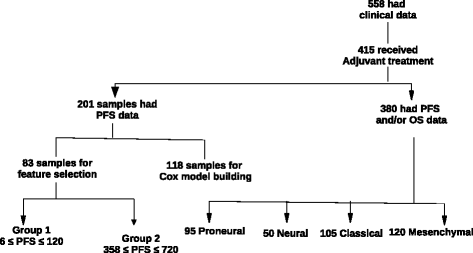
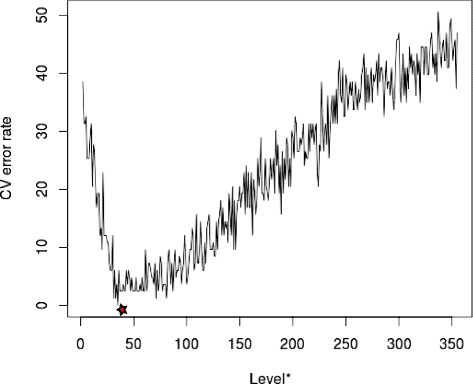
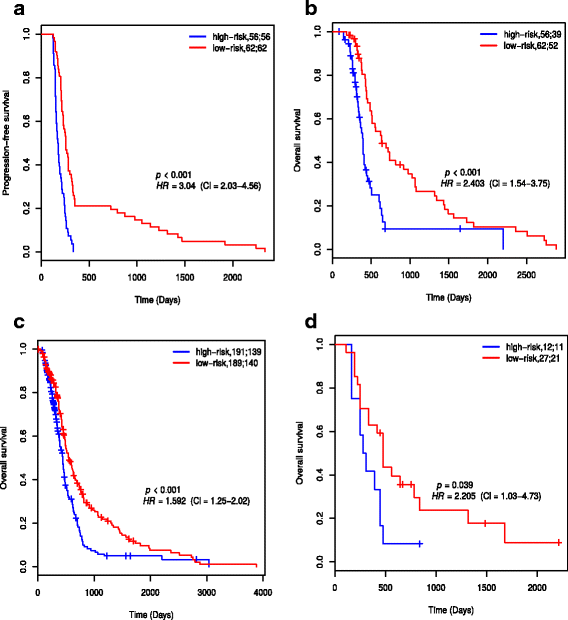
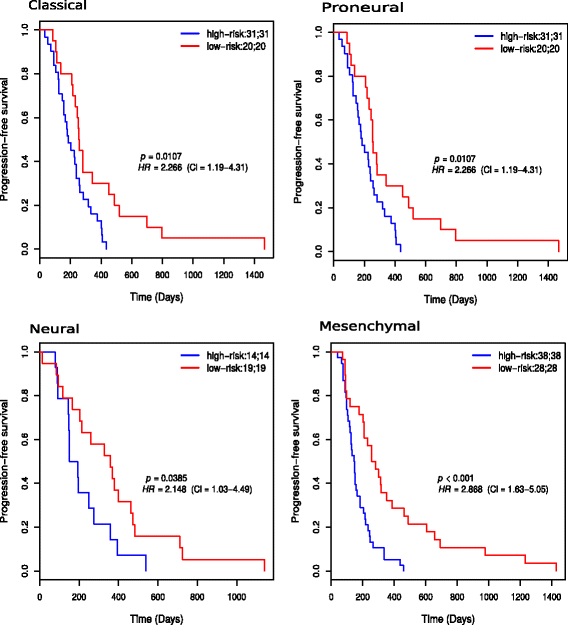
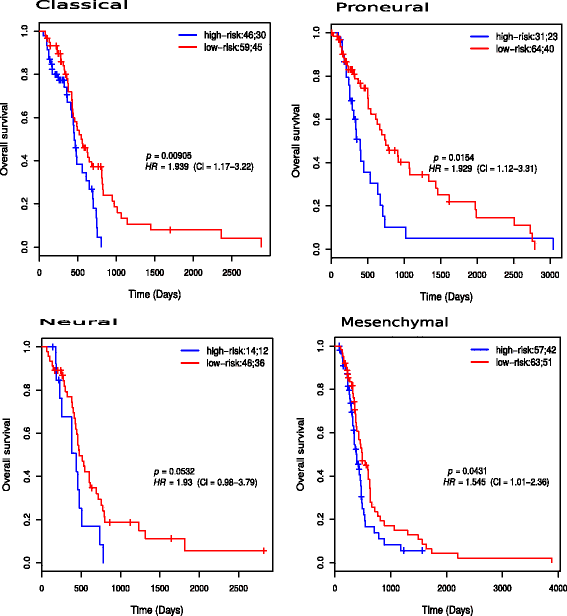
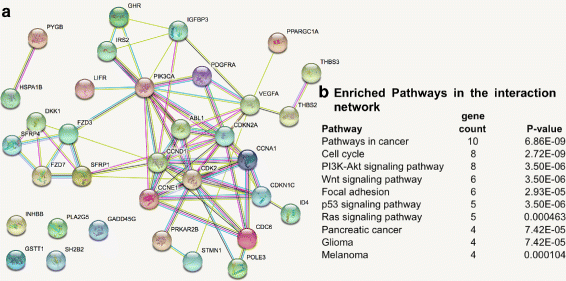
Similar articles
-
A five-miRNA signature with prognostic and predictive value for MGMT promoter-methylated glioblastoma patients.Oncotarget. 2015 Oct 6;6(30):29285-95. doi: 10.18632/oncotarget.4978. Oncotarget. 2015. PMID: 26320189 Free PMC article.
-
A long non-coding RNA signature in glioblastoma multiforme predicts survival.Neurobiol Dis. 2013 Oct;58:123-31. doi: 10.1016/j.nbd.2013.05.011. Epub 2013 May 29. Neurobiol Dis. 2013. PMID: 23726844
-
Machine learning revealed stemness features and a novel stemness-based classification with appealing implications in discriminating the prognosis, immunotherapy and temozolomide responses of 906 glioblastoma patients.Brief Bioinform. 2021 Sep 2;22(5):bbab032. doi: 10.1093/bib/bbab032. Brief Bioinform. 2021. PMID: 33839757 Free PMC article.
-
MicroRNA expression signatures determine prognosis and survival in glioblastoma multiforme--a systematic overview.Mol Neurobiol. 2014 Dec;50(3):896-913. doi: 10.1007/s12035-014-8668-y. Epub 2014 Mar 12. Mol Neurobiol. 2014. PMID: 24619503 Free PMC article. Review.
-
mRNA markers for survival prediction in glioblastoma multiforme patients: a systematic review with bioinformatic analyses.BMC Cancer. 2024 May 21;24(1):612. doi: 10.1186/s12885-024-12345-z. BMC Cancer. 2024. PMID: 38773447 Free PMC article.
Cited by
-
Integrative genomic analysis facilitates precision strategies for glioblastoma treatment.iScience. 2022 Oct 4;25(11):105276. doi: 10.1016/j.isci.2022.105276. eCollection 2022 Nov 18. iScience. 2022. PMID: 36300002 Free PMC article.
-
Molecular and Clinical Characterization of UBE2S in Glioma as a Biomarker for Poor Prognosis and Resistance to Chemo-Radiotherapy.Front Oncol. 2021 May 27;11:640910. doi: 10.3389/fonc.2021.640910. eCollection 2021. Front Oncol. 2021. PMID: 34123793 Free PMC article.
-
Multimetric feature selection for analyzing multicategory outcomes of colorectal cancer: random forest and multinomial logistic regression models.Lab Invest. 2022 Mar;102(3):236-244. doi: 10.1038/s41374-021-00662-x. Epub 2021 Sep 18. Lab Invest. 2022. PMID: 34537824
-
MicroRNAs, Hypoxia and the Stem-Like State as Contributors to Cancer Aggressiveness.Front Genet. 2019 Feb 20;10:125. doi: 10.3389/fgene.2019.00125. eCollection 2019. Front Genet. 2019. PMID: 30842790 Free PMC article. Review.
-
Mechanistic models of signaling pathways deconvolute the glioblastoma single-cell functional landscape.NAR Cancer. 2020 Jun 25;2(2):zcaa011. doi: 10.1093/narcan/zcaa011. eCollection 2020 Jun. NAR Cancer. 2020. PMID: 34316686 Free PMC article.
References
-
- Hegi ME, Diserens AC, Gorlia T, Hamou MF, de Tribolet N, Weller M, Kros JM, Hainfellner JA, Mason W, Mariani L, Bromberg JEC, Hau P, Mirimanoff RO, Cairncross JG, Janzer RC, Stupp R. MGMT Gene Silencing and Benefit from Temozolomide in Glioblastoma. N Engl J Med. 2005; 352(10):997–1003. 10.1056/NEJMoa043331. - PubMed
-
- Kim YS, Kim SH, Cho J, Kim JW, Chang JH, Kim DS, Lee KS, Suh CO. MGMT gene promoter methylation as a potent prognostic factor in glioblastoma treated with temozolomide-based chemoradiotherapy: a single-institution study. Int J Radiat Oncol Biol Phys. 2012; 84(3):661–7. 10.1016/j.ijrobp.2011.12.086. - PubMed
-
- Shen D, Liu T, Lin Q, Lu X, Wang Q, Lin F, Mao W. MGMT Promoter Methylation Correlates with an Overall Survival Benefit in Chinese High-Grade Glioblastoma Patients Treated with Radiotherapy and Alkylating Agent-Based Chemotherapy: A Single-Institution Study. PLoS ONE. 2014; 9(9):107558. 10.1371/journal.pone.0107558. - PMC - PubMed
-
- Melguizo C, Prados J, González B, Ortiz R, Concha A, Alvarez PJ, Madeddu R, Perazzoli G, Oliver JA, López R, Rodríguez-Serrano F, Aránega A. MGMT promoter methylation status and MGMT and CD133 immunohistochemical expression as prognostic markers in glioblastoma patients treated with temozolomide plus radiotherapy. J Transl Med. 2012; 10(1):250. 10.1186/1479-5876-10-250. - PMC - PubMed
-
- Costa BM, Caeiro C, Guimarães I, Martinho O, Jaraquemada T, Augusto I, Castro L, Osório L, Linhares P, Honavar M, Resende M, Braga F, Silva A, Pardal F, Amorim J, Nabiço R, Almeida R, Alegria C, Pires M, Pinheiro C, Carvalho E, Lopes JM, Costa P, Damasceno M, Reis RM. Prognostic value of MGMT promoter methylation in glioblastoma patients treated with temozolomide-based chemoradiation: a Portuguese multicentre study. Oncol Rep. 2010;23(6):1655–62. - PubMed
MeSH terms
Substances
LinkOut - more resources
Full Text Sources
Other Literature Sources
Medical

